White Oak Tree: Leaves, Bark, Fruit (Acorn) (Picture) – Identification
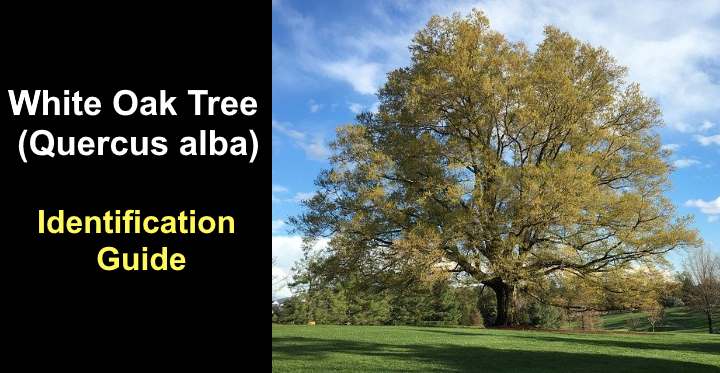
White oak tree is a majestic, deciduous tree identified by rounded-lobed leaves, red or pale green clusters of flowers (catkins), and small brown acorns. White oak trees are typically slow-growing large trees with a wide, spreading rounded crown. The large canopy of the oak tree makes it a beautiful shade tree for open landscapes and parks. White oaks are also easy to propagate from acorns or saplings, and their slow growth means you can plant one in a large backyard.
There are over 500 species of oak, with 90 species native to the United States. In the article, you will learn how to identify the white oak by observing the characteristics of the tree. Descriptions and pictures of the oak tree’s acorns, lobed leaves, and catkins will highlight the traits of this beautiful, stately landscape tree.
White Oak Tree Facts
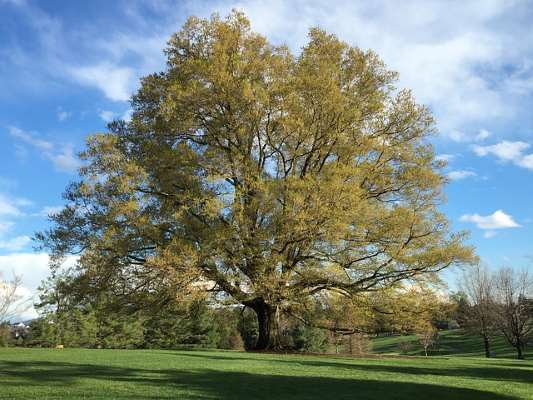
White oak tree (Quercus alba)
The white oak (Quercus alba) is a tall deciduous flowering tree that grows 50 to 135 ft. (15 – 41 m) high and up to 80 ft. (24 m) wide. White oaks are in the beech tree family Fagaceae, and the Quercus genus is native to the Northern Hemisphere.
Like all species of oak trees, the recognizable features of the white oak are its deeply lobed leaves and nut-like fruit called acorns. In addition, wood from oak trees is well known for its strength, durability, and hardness. As a result, timber from the white oak is the most widely used of all the native oak species.
White oak trees thrive in USDA zones 3 through 9 and perform best in full sun and well-drained loamy soil. Under most conditions, white oaks have slow to moderate growth, gaining between 12” and 24” (30 – 60 cm) per year. Additionally, white oaks have a long life span of 350 to 500 years.
The white oak tree has a pyramidal habit while immature. It gradually develops a spreading, rounded crown as it matures at around 100 ft. (30 m) tall.
One of the unique characteristics of white oak trees is that their foliage stays on the tree for a long time. Despite being deciduous, the oblong lobed oak leaves don’t drop until mid-winter. This habit gives the winter landscape some color when other trees are bare.
White Oak Tree Leaves

White oak leaves
Leaves on a white oak tree have rounded lobes, giving them a distinctive appearance. The white oak leaves measure 5” to 9” (12 – 22 cm) long and 2” to 4” (5 – 10 cm) wide. The tree leaf shape is described as oblong to obovate with finger-like lobes or sinuses.
Each leaf has between six and ten lobes that are rounded at the tip. Another identifying feature of the white oak leaves is the prominent yellowish midrib and veins on the bright green leaves.
White oak leaves are simple leaves with a short petiole that grow alternately on branches. Each oak leaf has a smooth texture and a bright to dark green color. The leaf underside is a pale green, almost white color. In fall, foliage color can range from shades of copper and brown to deep burgundy red.
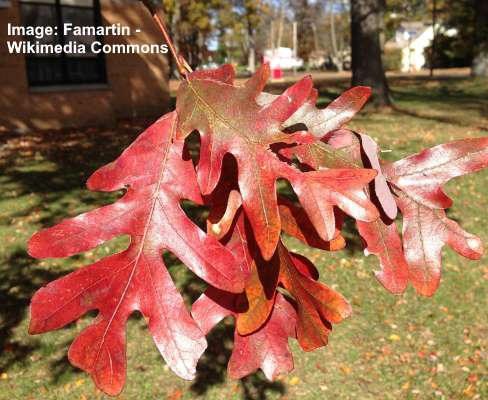
White oak autumn foliage
White Oak Tree Bark
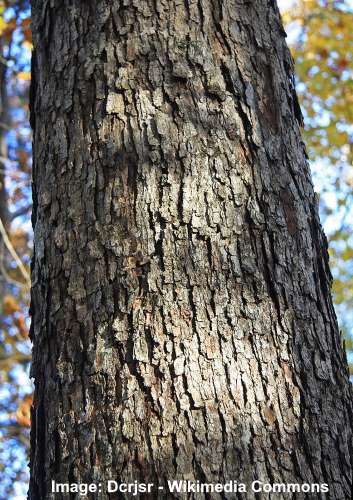
White oak bark
Bark on the white oak tree trunk and branches is light gray with a shallowly furrowed texture and narrow plates. As the white oak matures, bark can start to peel. The light gray bark on oak trees is similar among the species, making it challenging to identify the species by its bark alone.
White Oak Tree Flowers
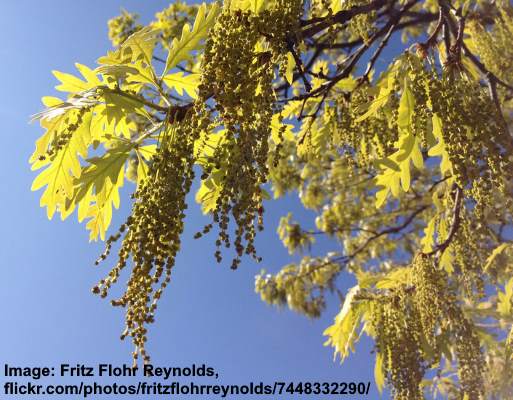
white oak male flowers
Flowers on the white oak tree are clusters of small dangling yellowish-green flowers or red spikes. White oak is a monoecious tree, producing male and female flowers. The male flowers are pendulous pale greenish catkins, whereas the female flowers are small red spikes. Typically, oak tree flowers are insignificant.
White oak trees bloom in spring. The yellowish-green oak catkins grow between 2” and 3.5” (5 – 9 cm) long. The greenish-red female flowers are hard to spot because they are small and bloom in the leaf axils.
White Oak Tree Fruit
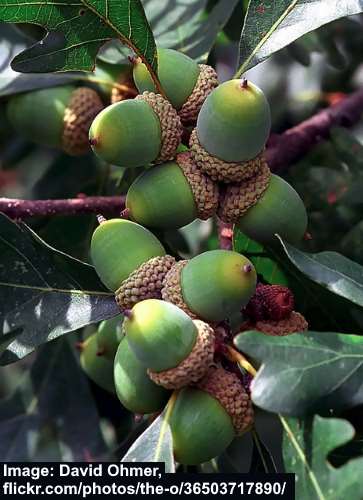
White oak immature acorns
After flowering, a white oak tree produces distinctive fruit in the form of brown nuts called acorns. The large nuts develop throughout the summer and mature in the fall of the first year. The nut shape is oval and tapers to a round tip. White oak nuts measure 0.5” to 1” (1.2 – 2.5 cm) long.
An identifiable feature of oak nuts is the bowl-shaped, woody cap. This cup-like growth is corky and light brown and covers about one-quarter of the nut. The knobby cup is a light tan color, contrasting with the nut’s light to dark brown color. White oak nuts are ready from September to November.
White Oak Acorns
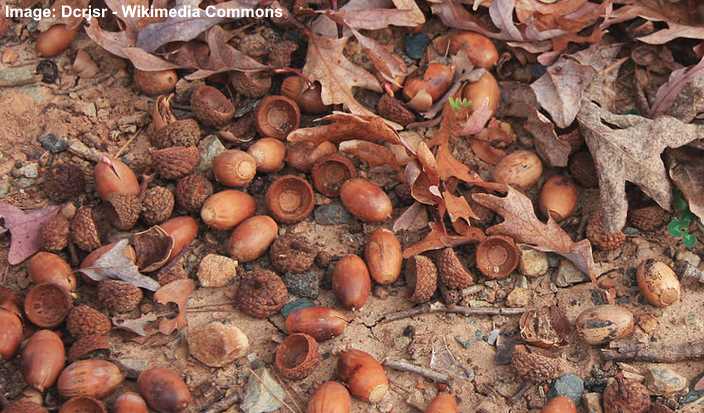
White oak acorns
The distinctive white oak acorns are the best way to identify the species.
White oak trees produce identifiable short light-brown acorns with a light gray-brown cup covered in warty scales. In addition, the cup which covers part of the acorn has warty scales. This contrasts with other species of oak trees that have reddish-brown, dark brown, or hairy cups that cover more of the acorn.
How to Identify White Oak
White oak identification is by its distinctive leaves and acorns. The recognizable white oak leaves grow up to 9” (22 cm) long. They are bright green with five to nine rounded lobes of varying sizes without bristle tips. In addition, white oaks produce characteristic light-brown acorns with knobby gray caps.
How to Plant an Acorn
With some patience, you can grow acorns into an oak tree in your garden. The acorns (oak tree seeds) are tricky to germinate, so you will need to collect a large handful in the fall. It would be best to wait for the last lot of acorns to fall for the best results. However, very soon, you will find that the planted acorn sprouts saplings that will eventually grow into large trees.
It’s important to note that white oak are acorn trees that only produce an excellent acorn crop every four to ten years.
To plant an acorn, first, remove the caps from the seeds as they are not part of the nut. Next, put the harvested acorns in a bucket of water overnight. Then discard any that are floating on the surface. The next step is to plant the acorns in small individual pots filled with a mixture of moist potting soil and peat moss. The nuts should be about 1” (2.5 cm) deep in the soil. Finally, thoroughly water the soil.
Keep the pots in a warm, sunny spot, making sure the soil is constantly moist but never soggy. During the germination stage, you’ll see little activity above ground. This is because a taproot is developing in the soil. Some growth should be visible after two to three months, with small saplings emerging from the pot.
How to Grow White Oak Saplings (Baby Oak Tree)
The time to transfer white oak saplings to the garden is when they are about 6” (15 cm) tall with a few leaves that have unfurled. After that, you can plant the saplings directly in the ground if you protect them from wildlife.
Choose the sunniest spot in your garden to plant your baby oak tree. It is vital to protect the tiny oak trees from damage by putting chicken wire fences around them. Immature white oak trees need protection until they are around 5 ft. (1.5 m) tall.
Proper watering of newly-planted oak trees is vital. You should thoroughly water the white oak every other day for the first 14 days after planting. Then, water once a week for the first three years if there hasn’t been much rainfall during the preceding week. After that, you can hold off watering during winter.
Regular trimming is necessary to help a baby oak tree grow into a sturdy landscape tree. This process is called to “limb it up.” This means pruning lower limbs under 2” (5 cm) in diameter where you don’t want branches on the mature tree. You will need to trim off the lower limbs after the first year the oak has been planted.
Where to Plant White Oak Tree
The best location to plant a white oak tree is in full sun and well-drained soil that stays relatively moist. Being a robust deciduous tree, a white oak adapts well to most soil types. For example, it performs well in acidic soil and can thrive in compacted soil. The oak tree also tolerates flooding, drought, and high soil salinity.
It’s good to remember that partial shade can affect a white oak tree’s growth. A mature white oak growing in partial or full shade can suffer from several diseases and pests. Additionally, the typical fall colors of the white oak—reddish-brown foliage—will be somewhat toned down and relatively unattractive.
Another consideration when deciding where to plant your white oak is the soil. Despite the tree being fairly robust, alkaline soil and shallow soil can stress the tree, especially as it grows to maturity.
White Oak (Quercus alba) Care Guide
White oak trees perform best in full sun and acidic, well-drained soil. A mature white oak requires little care, apart from additional watering in especially dry seasons. The best climate for oaks is dry summers and moist winters with some extra watering in the spring. Established white oaks don’t require fertilization.
How to Water White Oak Tree
Watering a white oak tree is crucial for the first season after planting in the ground. To water an immature or young white oak tree, deeply water it once a month. Generally, mature white oak trees don’t require additional watering, apart from extremely dry seasons.
To reduce the need for watering and keep a white oak healthy, a handy tip is to mulch beneath the canopy. Put a 3” to 4” (7.5 – 10 cm) layer of mulch around the tree’s root zone. The best type of mulch is pine needle or pine bark mulches. Remember to leave a 2” to 3” (5 – 7.5 cm) of empty space around the tree’s base to prevent issues with soil dampness.
White Oak Tree Fertilization
Under ideal conditions, a white oak tree doesn’t require additional fertilization. Usually, organic mulches or compost in the spring provide enough nutrients for the tree to thrive and stay healthy. However, if you decide to apply a tree fertilizer, choose one with low-nitrogen content to prevent weak branch growth.
How to Prune White Oak Tree
Pruning a white oak tree is crucial in developing a beautiful, robust landscaping tree. Therefore, it is vital to regularly prune decaying, dead, and crossed or rubbing branches in mid to late winter. As a rule, only prune oak trees that are three years or older.
During the regular pruning, pay attention to dead branches and ones rubbing together. However, proper pruning can help develop a beautiful shape as the tree matures.
The first step when pruning a white oak is to identify the dominant branch on the tree. It’s best to remove branches that are of a similar size as they can start competing. Next, trim the branches that may turn into leaders by cutting them back. This allows more sunlight to reach the other branches.
Always remember to prune the branch outside the branch collar and cut at an angle.
For pruning large oak trees in your garden, it’s always best to get a professional arborist to cut thick branches high up the tree.
Pests Affecting White Oak Growth
Despite being a sturdy tree, the white oak tree is susceptible to several pests that can affect its growth. Some tree bugs and insects to look out for are lace bugs, acorn weevils, oak sawflies, aphids, and caterpillars. Identifying these common garden pests is key to eradicating them.
Oak sawfly damage occurs when the tiny wasps lay eggs that hatch into sawfly larvae on white oak trees. The yellow and black worm-like creatures munch on the underside of leaves, eventually destroying them by skeletonizing them. The best protection against oak sawflies is to remove the larvae by hand. However, this may not be possible in a large infestation.
Lace bugs are tiny sap-feeding insects that feed on the underside of oak leaves. The pesky pests typically affect stressed or unhealthy oak trees.
Acorn weevils are small brown beetles that lay eggs inside acorns. The tiny cream-colored grubs can consume the contents of a whole acorn seed. However, they don’t harm the tree’s health.
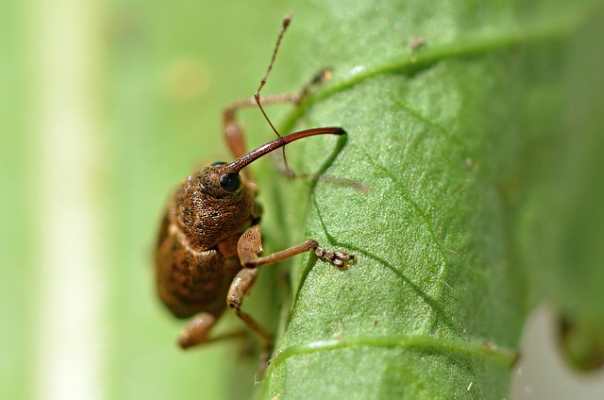
Acorn weevil
Giant bark aphids can infest oak trees and are one of the largest types of aphids. The grayish-black bugs feed on the sap of twigs and can cause twig die-back. However, healthy white oak trees are usually unaffected by these large pests.
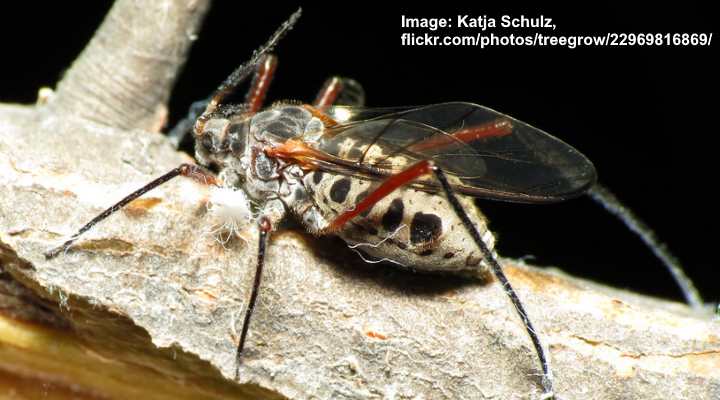
Giant bark aphid
Yellownecked caterpillars are small black and white striped larvae, 2” (5 cm) long, that can cause mild defoliation on a white oak tree. Young oak trees and saplings are most at risk, and it’s best to handpick the caterpillars and drop them in soapy water to kill them.
Diseases Affecting White Oak Growth
Several foliar and tree diseases can affect a white oak tree’s growth. Common conditions include oak gall, oak wilt, leaf blistering, and anthracnose. Here is some helpful information on spotting the signs of white oak tree diseases.
Anthracnose can occur on oak trees in the spring and causes large brown patches on leaf margins. The fungal disease commonly occurs during wet, cool weather and usually disappears by midsummer. The best way to control the fungal issue is to remove and destroy affected branches and leaves.
White oak gall (Andricus quercuspetiolicola) appears as small ball-like growths on white oaks and are seen on the leaf petioles. The oak galls are formed by parasitic wasps which lay eggs in the leaf stems.
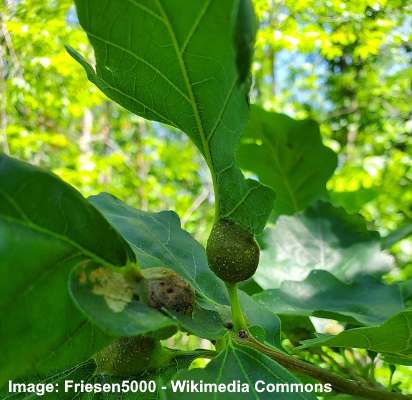
White oak gall
Oak tatters is a foliar disease affecting white oaks and causes oak leaves to appear lacy and shriveled. Emerging leaves appear “tattered” and have an unsightly appearance as if affected by anthracnose or oak sawflies. Unfortunately, there is little research into the cause of oak tatters. However, trees seem to recover well and start producing healthy leaves.
Related articles:
